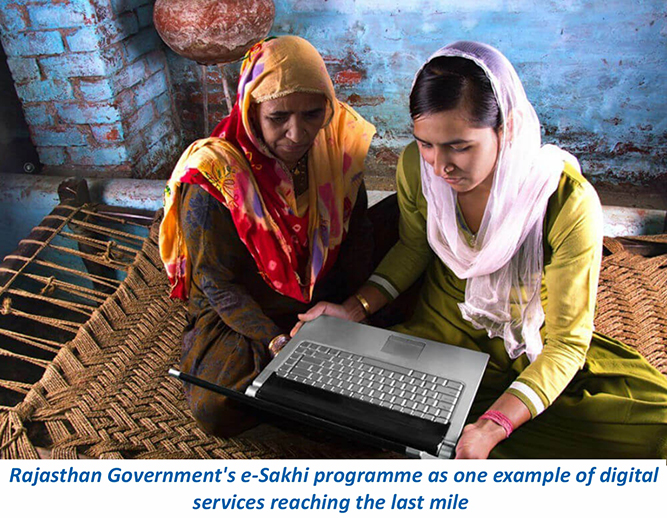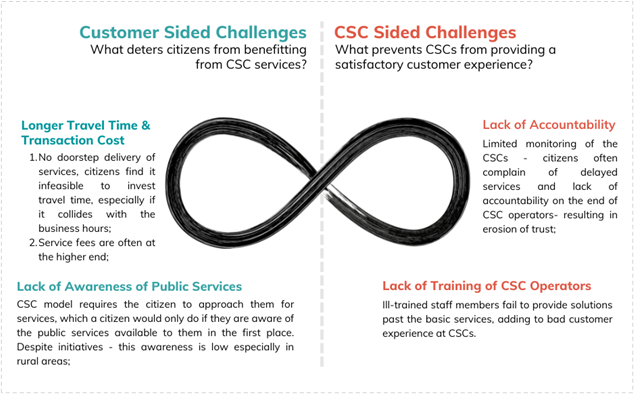|
Digital India has completed seven years in its attempt at enabling digital literacy, digital infrastructure creation as well as public service e-delivery that is inclusive and innovative.1 This flagship programme of the Government of India has had a positive impact since its launch in July 2015 in easing access to the internet and basic digital facilities. Take, for instance, the fact that the total number of internet connections in India has reached 834.29 million in 2022, almost tripling from 302.33 million in 2015. The rural–urban divide has narrowed down, albeit marginally, with the share of rural areas growing from 35.58% of the total pie in 2015 to 40.35% today (Statista 2022). Information and Communication Technologies (ICTs), such as the ones Digital India introduces, have become more than just mere devices of connectivity; they now signify opportunity and empowerment for millions of people across rural India. They have the power to catalyse entrepreneurial capabilities among low-income households struggling within traditional sources of employment such as agriculture. For women, they have the ability to transform lives by overcoming traditional gender barriers, which prevail at home and in the marketplace. The government recognises this immense power of ICTs and has made several efforts to increase their access and delivery in rural regions.
Moreover, the CSC programme has the potential to mobilise women’s entrepreneurship in rural pockets of India. This is necessary due to the overwhelming gender gap in access to the internet and mobile technology in the country. Research indicates that in India, men are 28 percentage points more likely than women to own a mobile phone (Pew Research Center 2019). The situation is worse in rural areas where men are twice as likely to have used the internet as women in a 49% to 25% ratio (GoI 2021). All these data are a matter of concern because access to the right technology has immense benefits, not only for expanding a woman's entrepreneurial abilities, but also for the economic advancement of her entire community. While the CSC network and gender-inclusive schemes like Vidyut Sakhi and BC Sakhi aim to be inclusive, gaps do exist in practice. Key issues such as longer travel time and transaction cost, low digital literacy, lack of training for CSC operators, language barriers, lack of infrastructure, and lack of awareness of e-government services continue to plague the system (Sharma, Metri, Dwivedi, et al. 2021; Figure1). These challenges have impacted the potential of ICT to produce an equitable and sustainable culture of entrepreneurship in the country.
Figure 1. Key challenges in the Common Service Centres
model. Despite the promises of Digital India and the ubiquitous presence of mobile phones and internet services in our lives today, the evidence highlights that the reality of ICT access in India is much different. But the challenges discussed above should not discourage us. Several initiatives by civil society organisations, for-profit social enterprises, and in fact, financial institutions have emerged in recent times with valuable lessons that can help shape the evolution of the ICTs and women’s entrepreneurship nexus in India and other emerging economies (Malhotra, Kanesathasan, and Patel 2012). These initiatives from entities such as HDFC Bank, AISECT, Hand-in-Hand, and Mann Deshi Mahila Sahakari Bank, to name a few, alongside initiatives here at DA recognise the power of ICTs as an agent of change to bring about economic transformation for the country. Documenting these models and learning from them can help policymakers and practitioners fill in the gaps in their initiatives as well as work on scaling up already successful initiatives on the ground. By catalysing the immense reach of ICTs, there is an opportunity today to bring about a digital revolution for millions of women across rural India. References GoI (Government of India). 2021. Release of NFHS-5 (2019-21) – Compendium of factsheets. New Delhi: Ministry of Health and Family Welfare, GOI. Details available at https://main.mohfw.gov.in/basicpage-14, last accessed on 26 August, 2022. Malhotra, A., Kanesathasan, A., and Patel, P. 2012. Connectivity: How mobile phones, computers and the internet can catalyze women's entrepreneurship. Washington, DC: International Center for Research on Women (ICRW). Details available at https://www.icrw.org/wp-content/uploads/2016/10/Connectivity-how-mobile-phones-computers-and-the-internet-can-catalyze-womens-entrepreneurship.pdf, last accessed on 09 September, 2022. Pew Research Center. 2019. Mobile Connectivity in Emerging Economies. Pew Research Center. Washington, DC: Pew Research Center. Details available at https://www.pewresearch.org/internet/2019/03/07/mobile-connectivity-in-emerging-economies/, last accessed on 09 September, 2022. Sharma, S. K., Metri, B., Dwivedi, Y. K., and Rana, Y. K. 2021. Challenges common service centers (CSCs) face in delivering e-government services in rural India. Government Information Quarterly, 38 (2). Details available at https://doi.org/10.1016/j.giq.2021.101573, last accessed on 09 September, 2022. Statista. 2022. Number of internet connections in rural and urban areas of India from financial year 2015 to 2022. Statista. Details available at https://www.statista.com/statistics/1196721/india-internet-connections-in-rural-and-urban-areas/, last accessed on 26 August, 2022. Footnote 1Read more about the Digital India Programme at https://www.digitalindia.gov.in/.
Saundharaya Khanna
Simantini Ray
|
 One such case is that of the Common Service Centres (CSC) Scheme.
One such case is that of the Common Service Centres (CSC) Scheme.